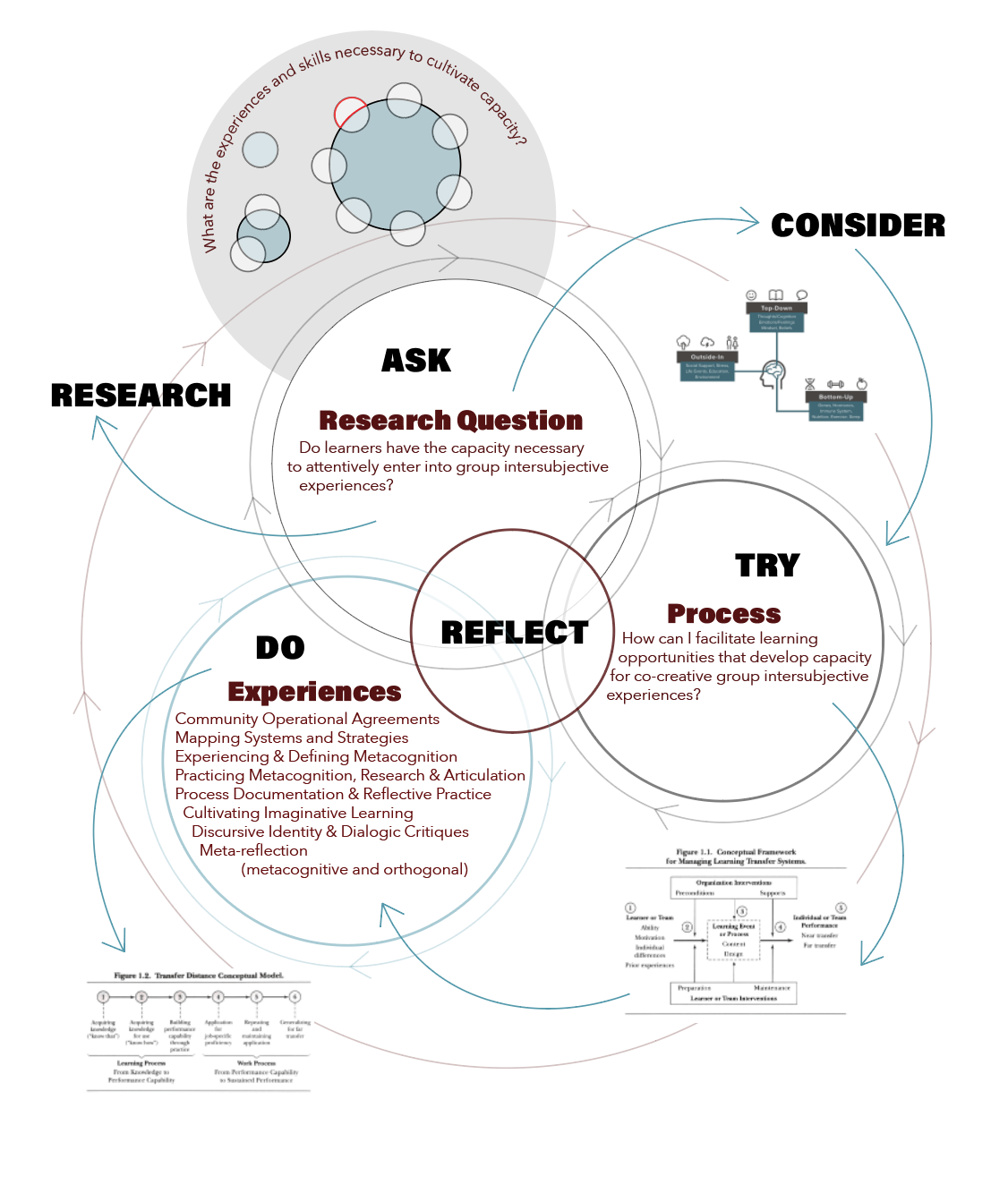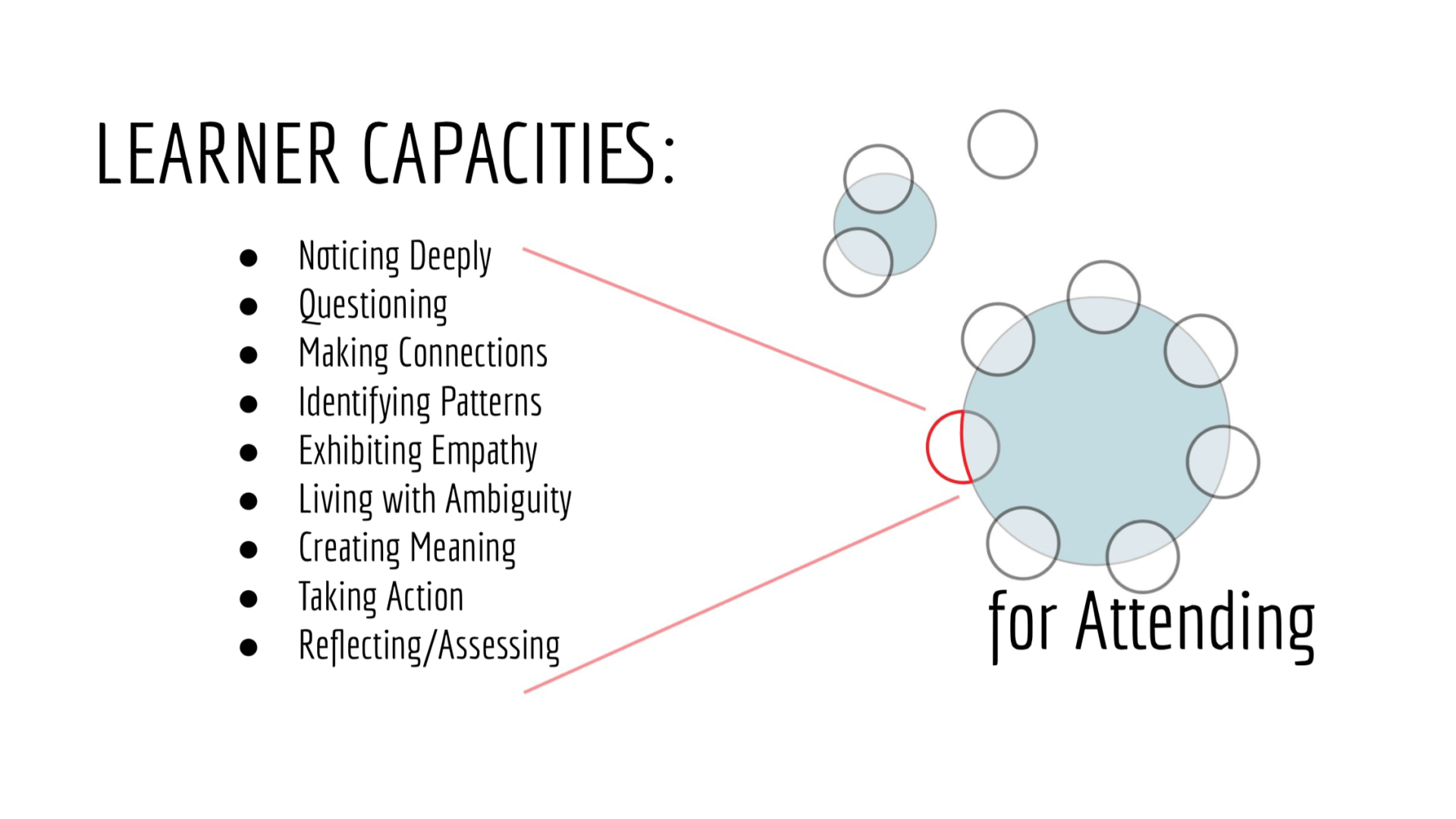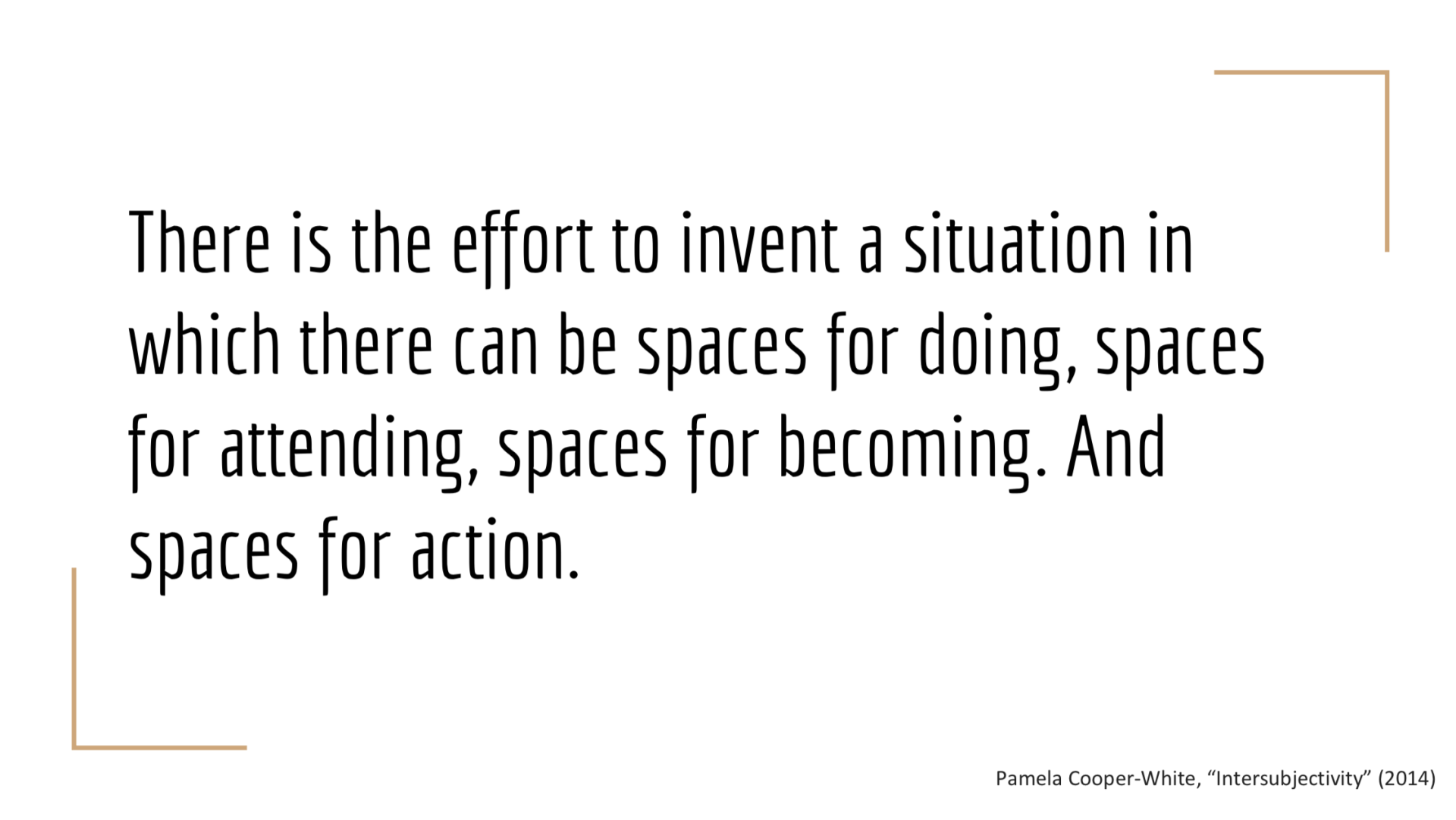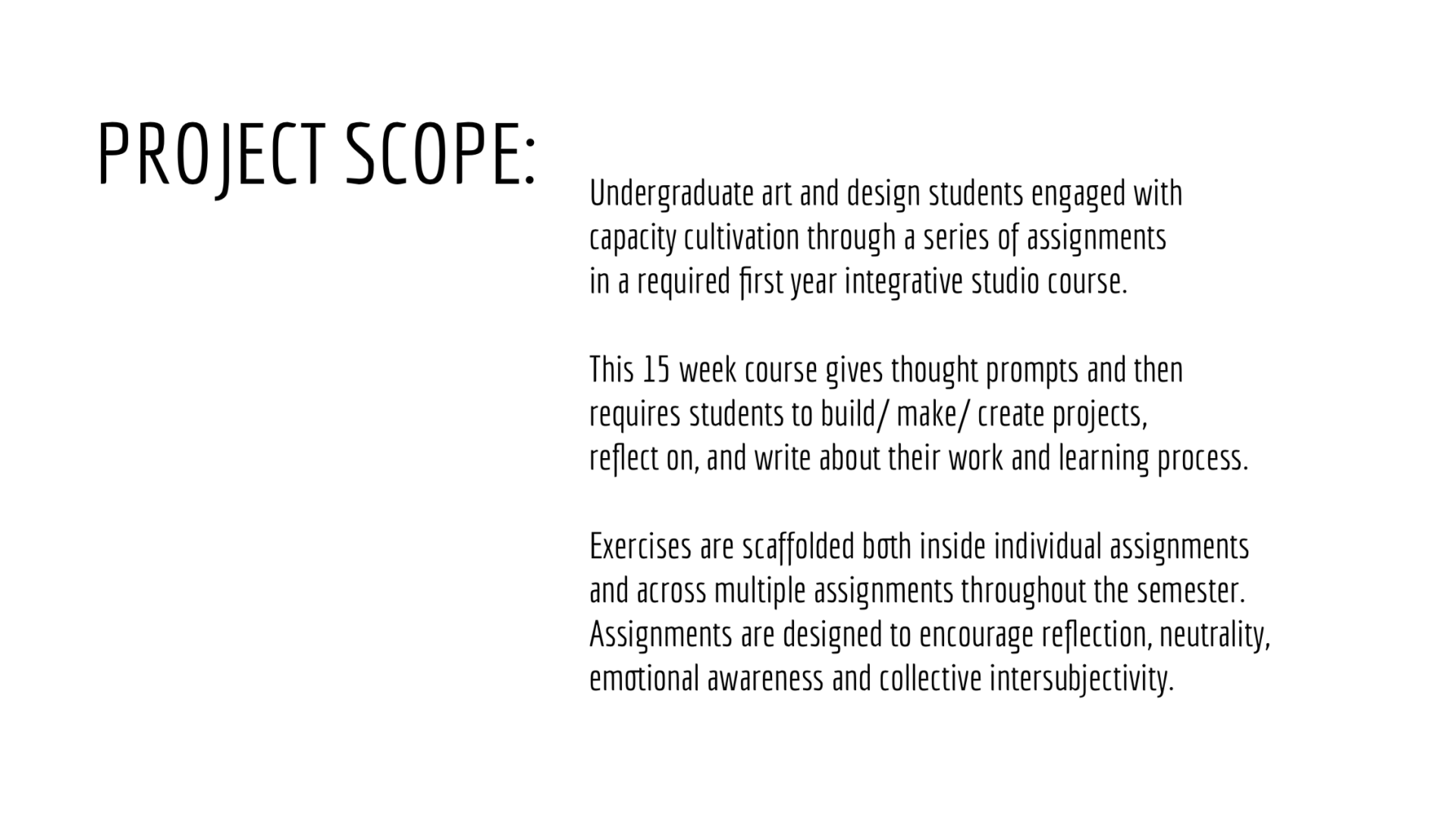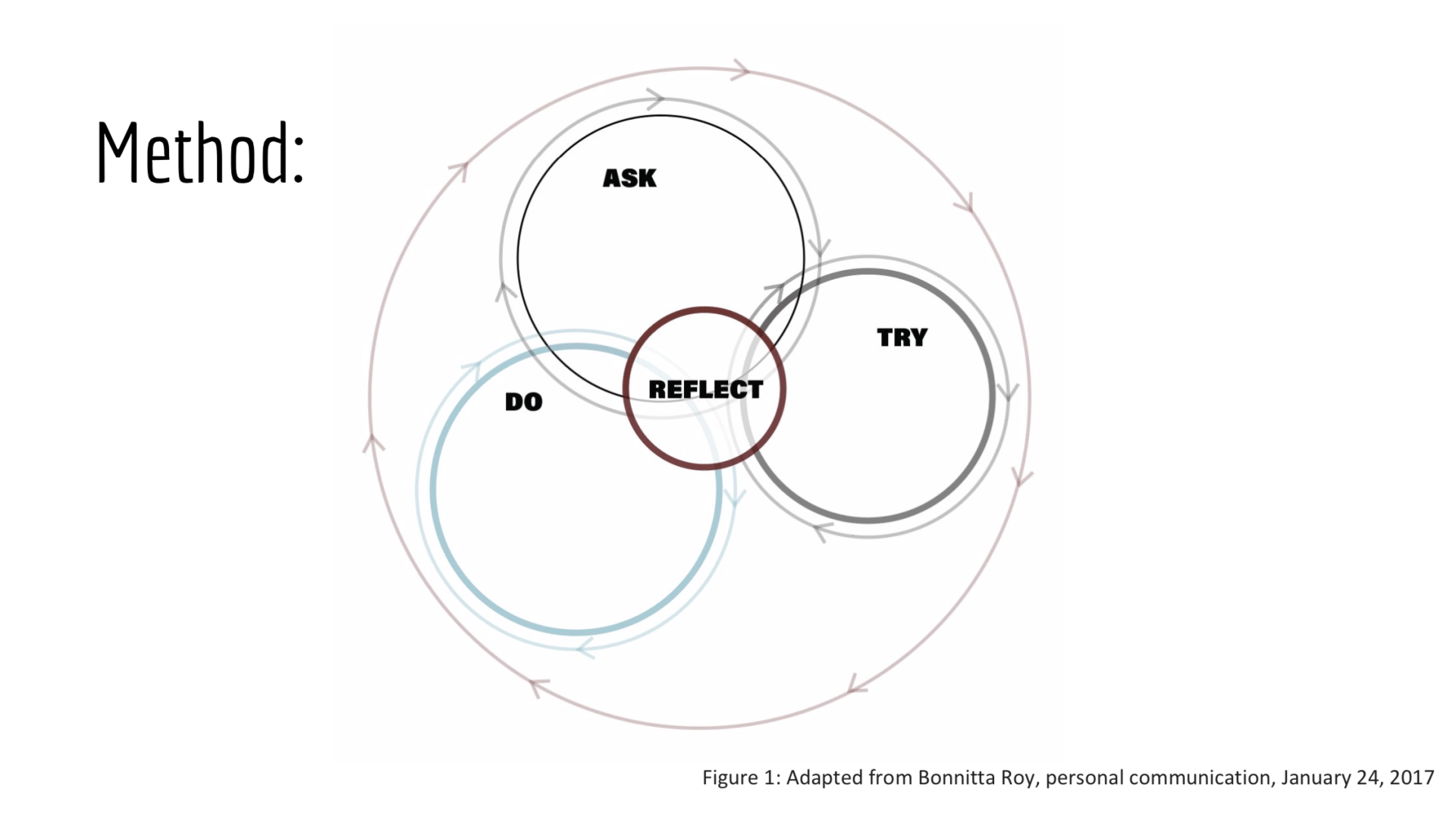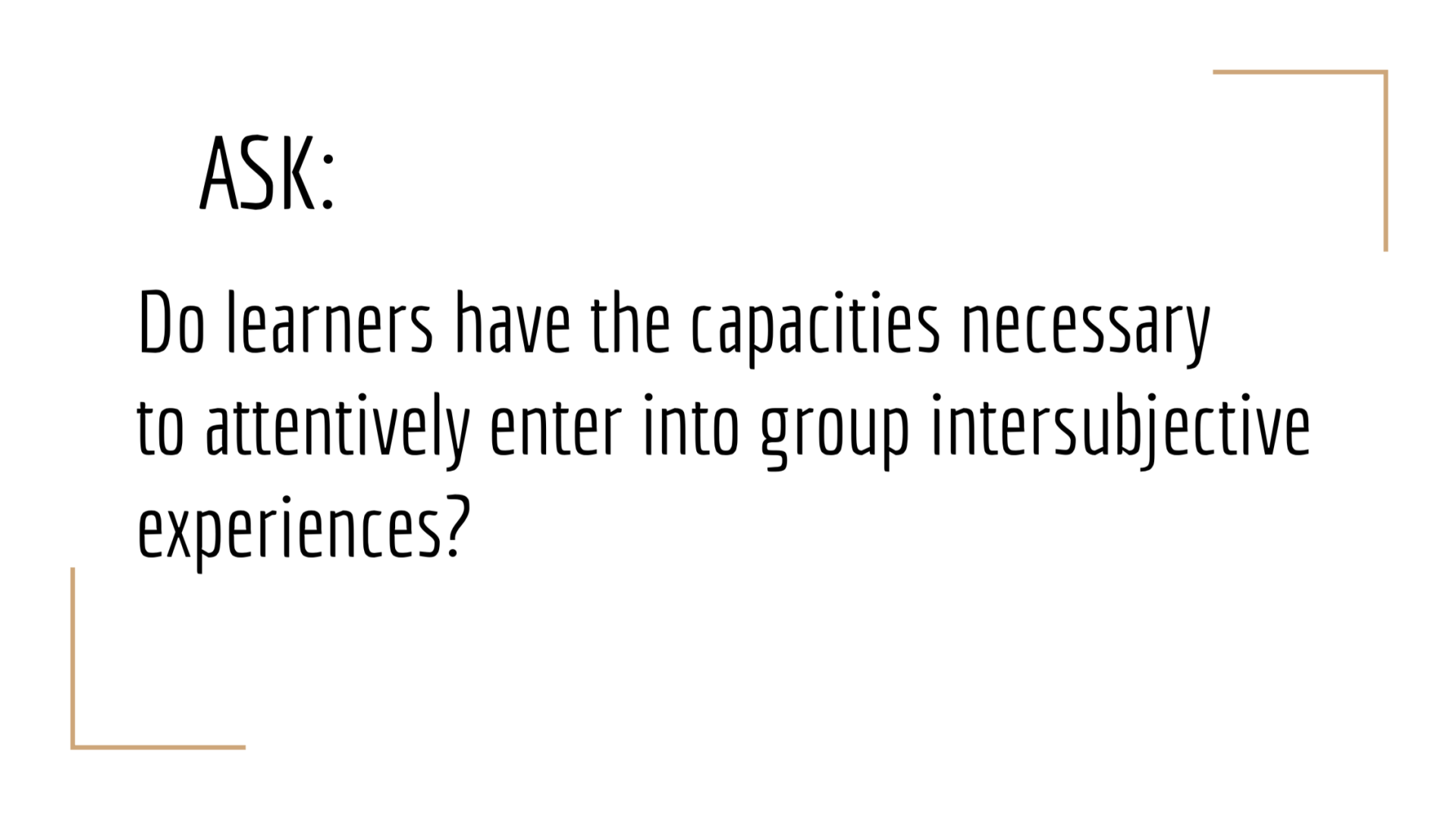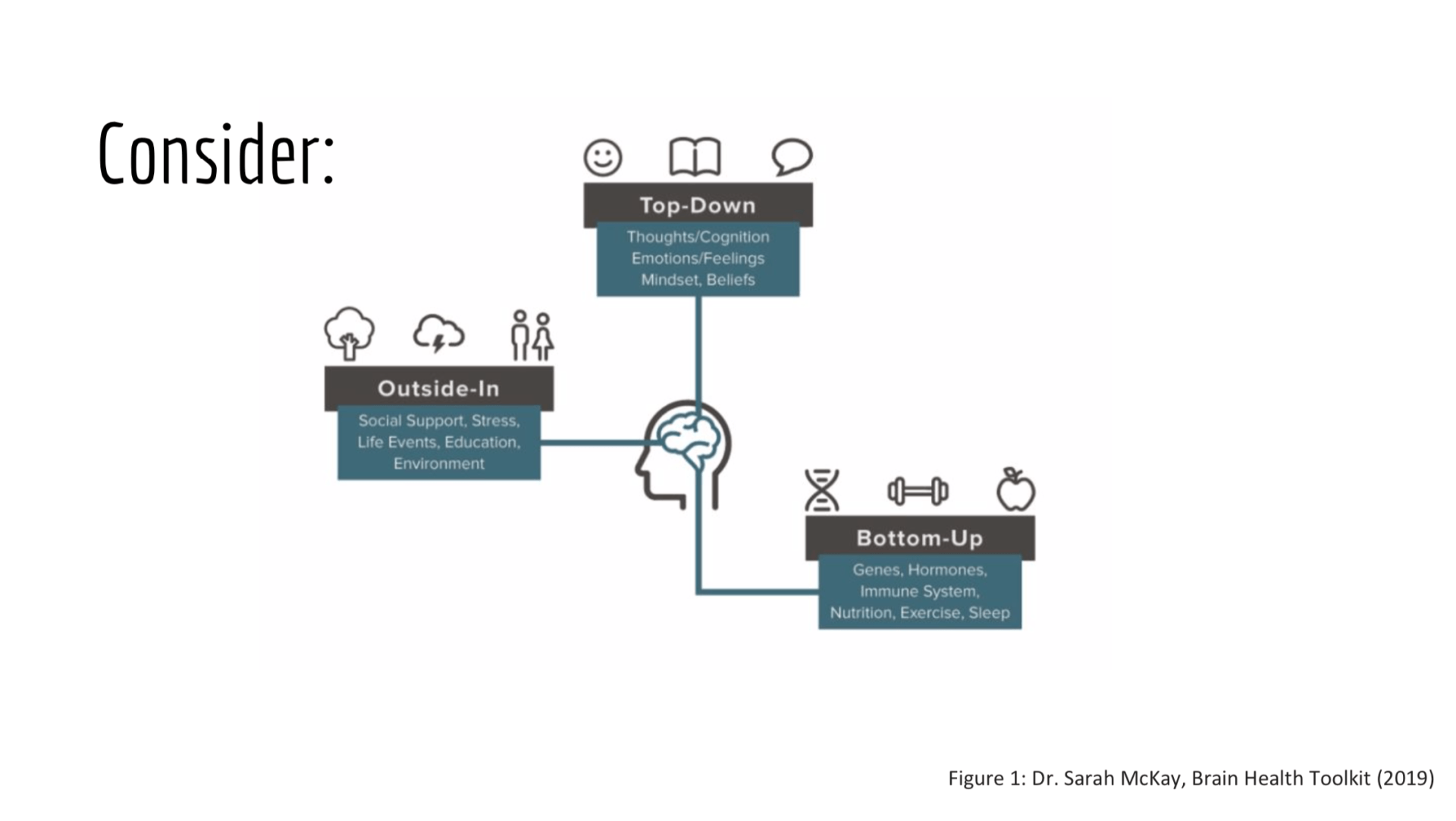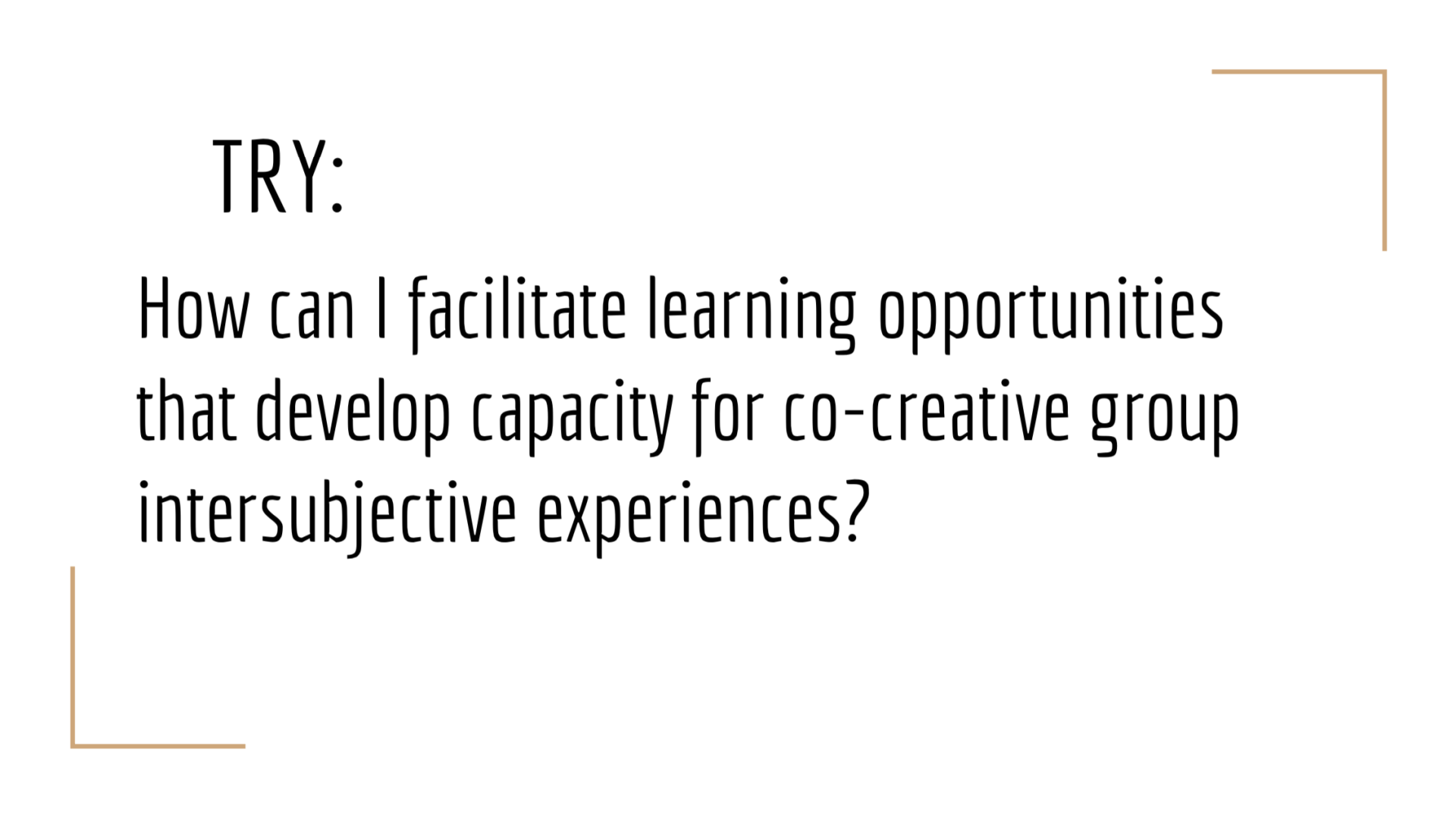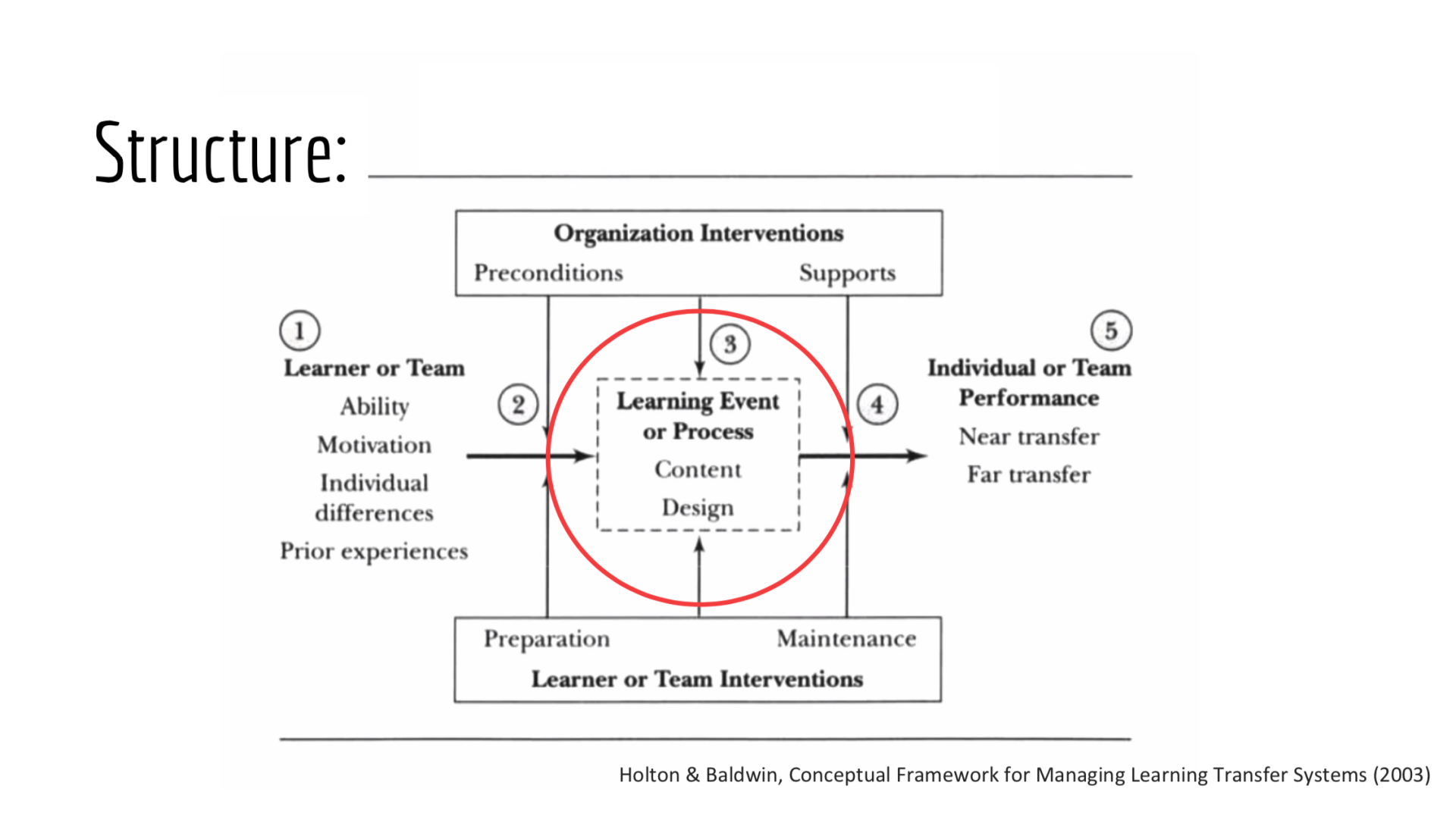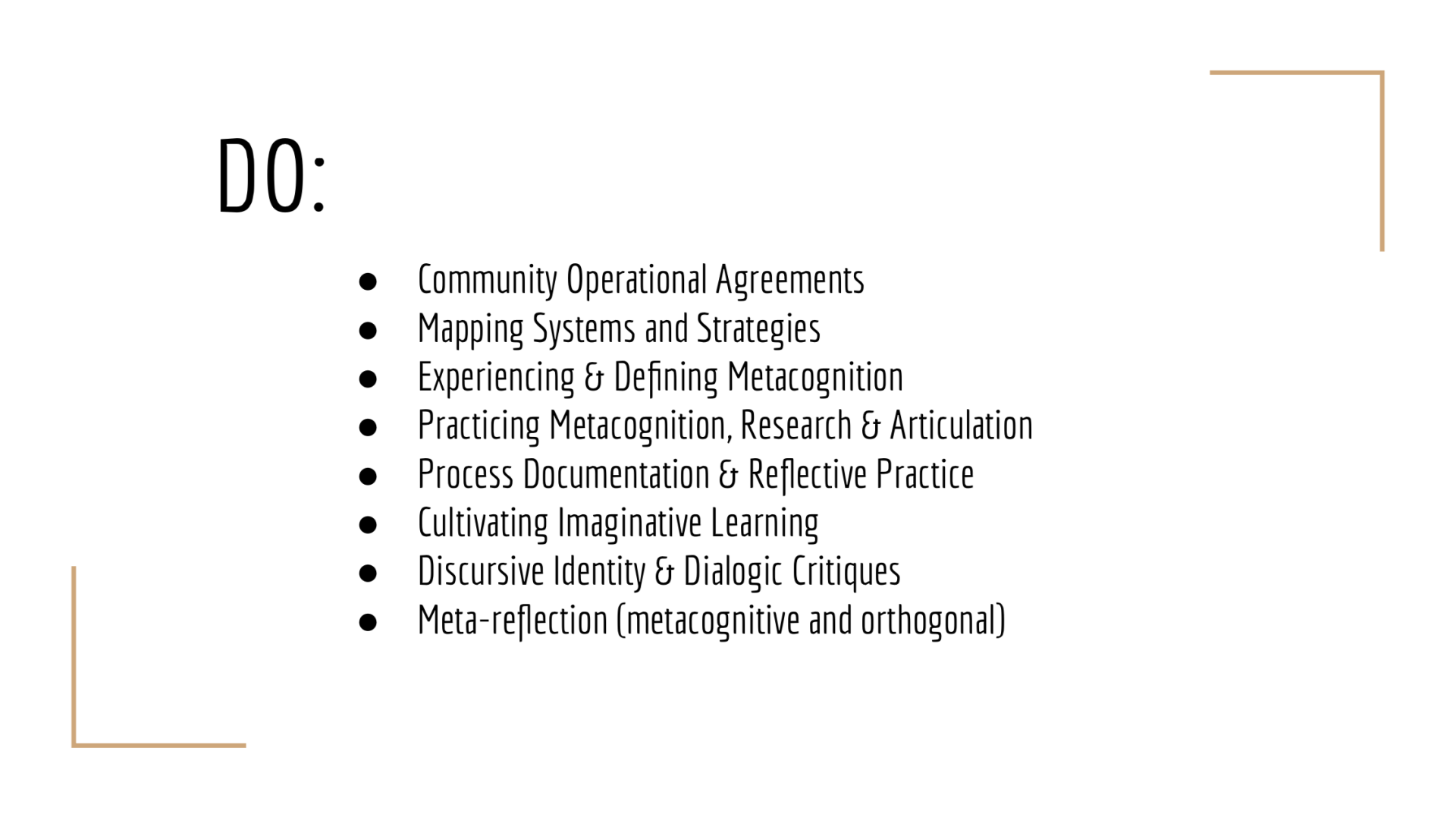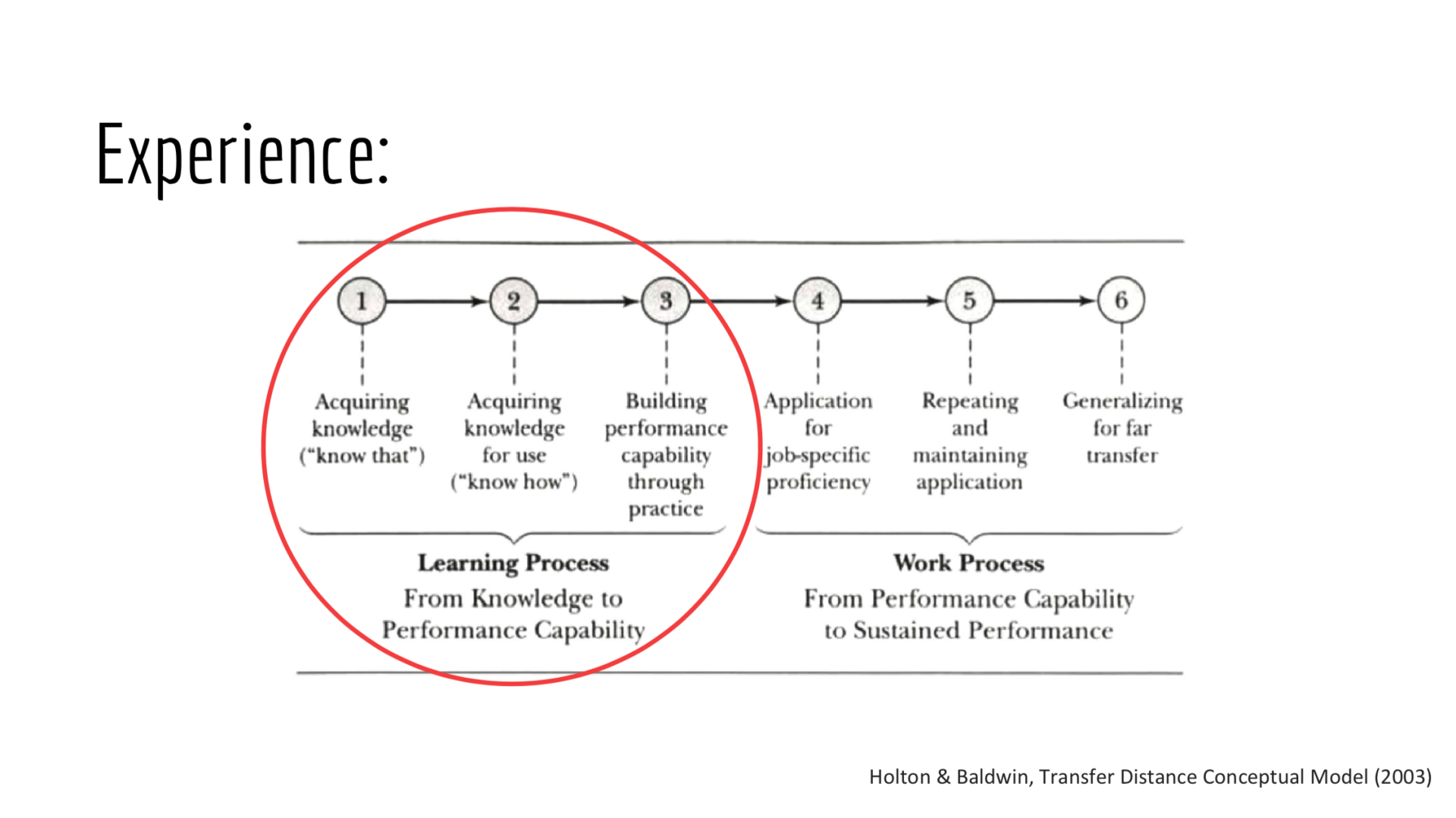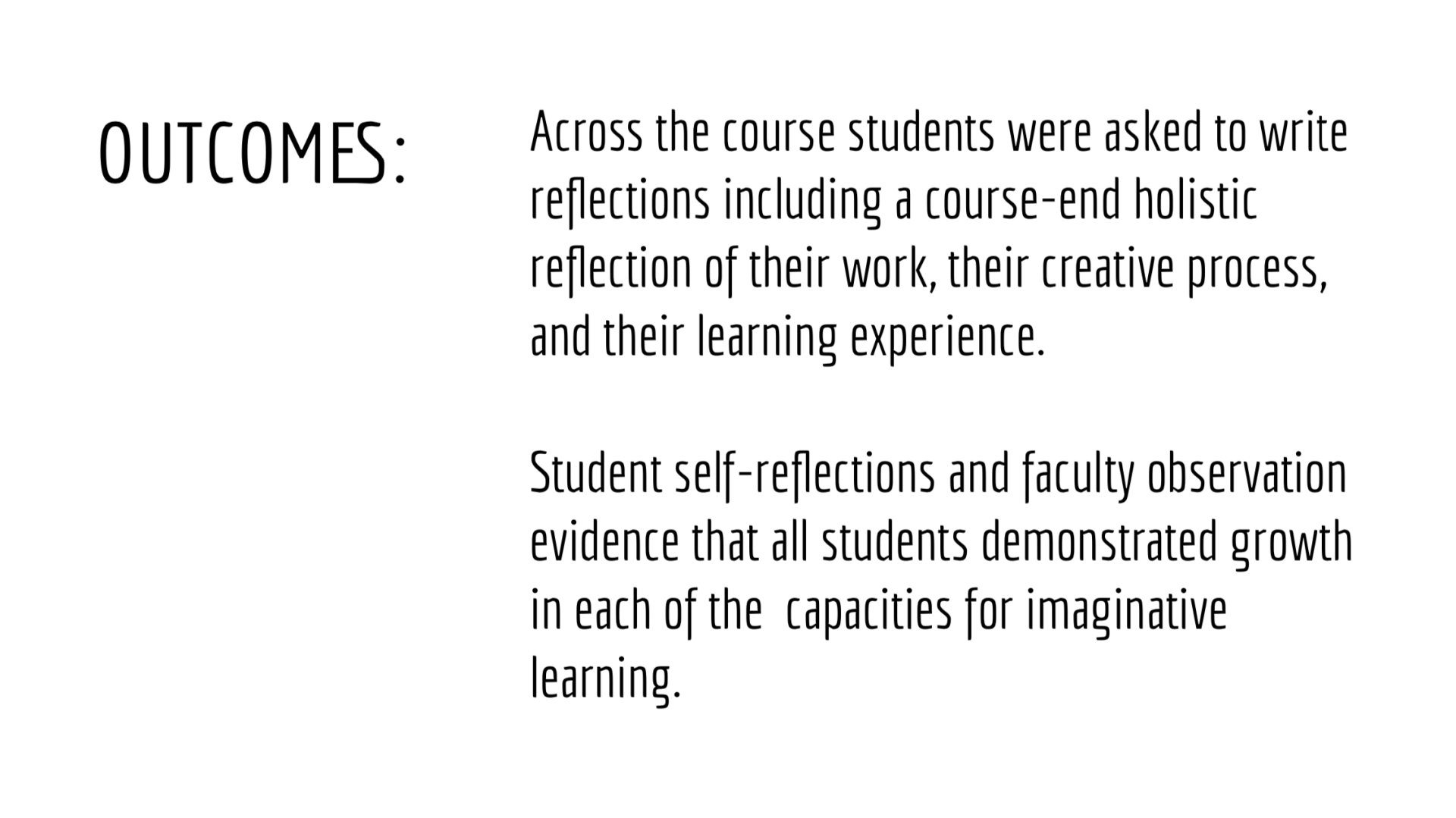Collective Intersubjectivity
CULTIVATING CAPACITY FOR COLLECTIVE INTERSUBJECTIVITY THROUGH
REFLECTIVE PRACTICE, GUIDED CRITIQUE AND METACOGNITIVE AWARENESS
Hypothesis: If learner capacity is cultivated then collective intersubjective experiences will be more equitable, accessible and pluralistic.
REFERENCES:
Alderfer, C. P. (2014). The Five Laws of Embedded Intergroup Relations Theory. In The Practice of Organizational Diagnosis: Theory and Methods. Retrieved May 12, 2019, from https:// ebookcentral-proquest-com.libproxy.newschool.edu
Bohm D. (1985). Unfolding meaning: A weekend of dialogue. London: Routledge.
Bohm, D. (1996). On dialogue. London, England: Routledge.
Bohm, D., Factor, D., & Garrett, P. (n.d.). Dialogue - A Proposal. Retrieved May 12, 2019, from http://www.david-bohm.net/ dialogue/dialogue_proposal.html
Cooper-White P. (2014) Intersubjectivity. In: Leeming D.A. (eds) Encyclopedia of Psychology and Religion. Springer, Boston, MA
Cozolino, L. (2006). The Neuroscience of Human Relationships: Attachment and the Developing Social Brain. New York: Norton.
de Quincey, Christian (2000). Intersubjectivity: Exploring consciousness from the second-person perspective. Journal of Transpersonal Psychology, 32 (2), 135-155.
Dewey, J. (1980). Art as Experience. New York: Perigree Books.
Erskine, R. G. (1991). Transference and transactions: Critique from an intrapsychic and integrative perspective. Transactional Analysis Journal, 21, 63-76.
Erskine, R.G. (2013). Relational Group Process Developments in a Transactional Analysis Model of Group Psychotherapy. Transactional Analysis Journal, 43 (4), 262-275.
Greene, M. (1993, Winter). Diversity and Inclusion: Toward a Curriculum for Human Beings. Teachers College Record, 95(2), 211-221.
Greene, M. (2001). Variations on a blue guitar; the Lincoln Center Institute lectures on aesthetic education. New York, NY: Teachers College Press.
Ha’iri Yazdi, M. (1992). The principles of epistemology in Islamic philosophy: Knowledge by presence. Albany, NY: SUNY.
Hart, C. E. (2016). Anti-Oppression Imaginaries: Art, Process, and Pedagogy (dissertation). Retrieved from https://libres.uncg.edu/ir/uncg/f/Hart_uncg_0154D_12028.pdf
Holton, E. F., III, & Baldwin, T. T. (2003). Making Transfer Happen: An Action Perspective on Learning Transfer Systems., Improving Learning Transfer in Organizations (pp. 3-15). Jossey- Bass.
Holzer, M. F. (2007). Aesthetic Education, Inquiry and the Imagination. Retrieved May 12, 2019, from http:// 2014.creativec3.org/data/AE_Inquiry_and_the_Imagination.pdf
Martín, B. y Martínez, J.M. (2009). Psicoterapia de grupo en una unidad de agudos Revista de la Asociación Española de Neuropsiquiatría, 29 (103): 79-96.
Murray, T. (2013, March). Meta-Sangha, Infra-Sangha: Or, Who is this "We" Kimo Sabe? Retrieved August 8, 2019, from http://www.beamsandstruts.com/essays/item/1181-meta-sangha-infra-sangha-or-who-is-this-we-kimo-sabe
Rodriguez, J. M. M. (2017). Intersubjective Aspects of Relational Group Process: From Exclusion to Integration. International Journal of Integrative Psychology, 8. Retrieved May 12, 2019, from www.integrative-journal.com/index.php/ijip/article/ download/141/88.
Sauder School of Business. (n.d.). Ask.Try.Do [Brochure]. Author. Retrieved May 12, 2019, from http://dstudio.ubc.ca/research/ strategic-design/ask-try-do/
Siegel, D.J. (2006). An Interpersonal Neurobiology Approach to Psychotherapy: Awareness, Mirror Neurons, and Neural
Plasticity in the Development of Well-Being. Psychiatric Annals. In press. Retrieved May 12 2019, from http:// www.researchgate.net/publication/241200655_An_Interpersonal_Neurobiology_Approach_to_Psychotherapy_Awareness_Miror_Neurons_and_Neural_Plasticity_in_the_Development_of_Well-Being.
Siegel, D. J. (2001). Toward an Interpersonal Neurobiology of the Developing Mind: Attachment Relationships, "Mindsight", and Neural Integration. Infant Mental Health Journal, 22(1-2), 67-94. doi 10.1002/1097-0355(200101/04)22:13.0.CO;2-G
Stolorow R.D. & Atwood G.E. (1979). Faces in a Cloud: Intersubjectivity in Personality Theory. New Jersey: Jason Aronson.
Terhart, E. (2003). Constructivism and teaching: A new paradigm in general didactics? Journal of Curriculum Studies, 35(1), 25–44. doi: 10.1080/00220270210163653
The Neuroscience Academy. (2018). Health and Wellness Practitioner's Brain Toolkit: Handpicked Tools for Using Neuroscience Wisely [Brochure]. McKay, S. Retrieved May 12, 2019, from https://yourbrainhealth.leadpages.co/toolkit/
Tomasello, Michael 2001. The Cultural Origins of Human Cognition. Cambridge, MA: Harvard University Press.
Voloshinov, V. N. (1973). Marxism and the philosophy of language (L. Matejka & 1. R. Titunik, Trans.). New York and London: Seminar Press.
Whorf, B. L. (1956). Language. thought, and reality. New York: John Wiley & Sons.
Zahavi, D., & Overgaard, S. (n.d.). Intersubjectivity. In International Encyclopedia of Ethics. Retrieved May 12, 2019, from https://onlinelibrary.wiley.com/doi/pdf/ 10.1002/9781444367072.wbiee274.

